-
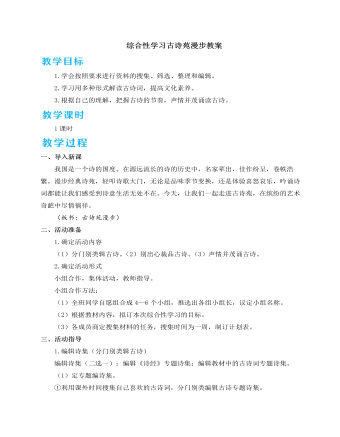
人教部编版语文八年级下册综合性学习古诗苑漫步教案
解说词:画卷上的竹子,在石缝中挺然而立,坚韧不拔,遇风不倒。郑板桥先生借竹抒发了自己的洒脱与豁达,表现了他勇敢面对现实、绝不屈服于挫折的品性,令竹子人格化了。此时,“诗是无形画,画是有形诗”。4.声情并茂诵古诗(播放相关的主题图片和音乐,尽量让诗歌和音乐、画面相融合)主持人:诗除了追求意境的图画美之外,还特别注重节奏和韵律,具有音乐美。我们理解了诗中的情愫后,便可以通过朗读来诠释这种种情愫,或低声絮语,或慷慨悲吟,或温情述说……请大家选择自己最喜欢的一首诗词或一小节诗歌,用你认为最贴切的情感和方式朗读,并说出这样处理的原因,或讲述你与此诗有关的故事。朗读示例:无言/独上西楼,月/如钩,寂寞梧桐/深院/锁/清秋。剪不断,理还乱,是离愁,别是/一般滋味/在心头。解说词:此词是南唐后主李煜被囚于宋时所作,表达了他离乡去国的锥心之痛。朗读时要表现出那种深切的故国之思、亡国之恨。
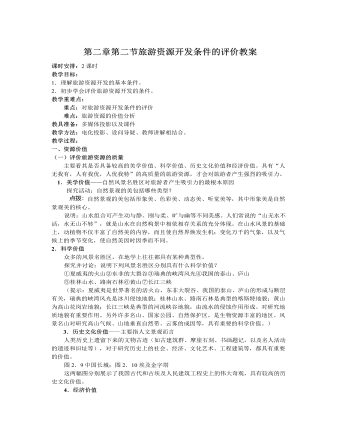
人教版高中地理选修3第二章第二节旅游资源开发条件的评价教案
案例①武夷山景区通过对案例①的学习,了解到:①武夷山景区自然景观优美,并具有较高的科学价值(丹霞地貌和生物多样性)、历史文化价值(丰富的文化遗存),具有极高的旅游资源价值。②地理位置优越和交通条件便利、基础设施完善。③武夷山的国内客源市场主要集中在长江三角洲和珠江三角洲,国际客源市场主要分布在以新加坡、日本为主的亚洲。游客多,市场广阔。通过分析,进一步了解旅游资源开发条件评价的基本内容。图2.15武夷山景区旅游略图通过图2.15了解了武夷山著名景区、景点的分布。活动根据案例,结合图2.15,试对武夷山景区的开发条件进行评价提示:可按以下步骤进行;1.根据学生各自的兴趣爱好和性格,自由组合分组。2.仔细阅读本案例,各组确定自己感兴趣的评价项目,并通过新闻媒介、网络、书籍等进一步收集有关信息。3.小组信息汇总,进行组内讨论。4.小组在全班进行汇报交流。
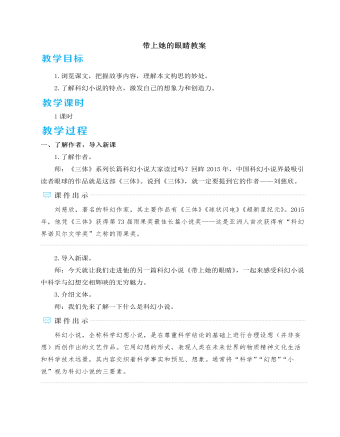
人教部编版七年级下册带上她的眼睛教案
在人物方面,刘慈欣的小说继承了古典科幻小说中的人物塑造规律,即无论是技术专家还是普通人,他们一定要在社会的变革中被推向改变世界的精英舞台。在情感线索方面,刘慈欣与其他新生代作家的主要区别是,他很少将男女关系置于情感的中心位置(虽然他的男女情感写得细腻而成熟)……在他的作品中,科学的诗意永远是一种基本情调。疑难探究如何理解小说中的“我”和小姑娘这两个人物形象?小说的主要人物是“我”与“她”(小姑娘)。“我”是小说的叙事者,也是小说中“行动着”的人,起着串联情节的作用。“我”的性格既有开朗热情的一面,也有灰色伤感的另一面,内心深处的悲悯情怀,使“我”这个形象更加丰满。小姑娘作为地航飞船的领航员,身处险境而不惊恐,不慌乱,还不告诉“我”自己所处的位置,不倾诉自己的郁闷,以大无畏的精神继续坚守岗位,不仅表现出勇敢、乐观、坚韧的品质,更带有一种悲壮的英雄主义色彩。
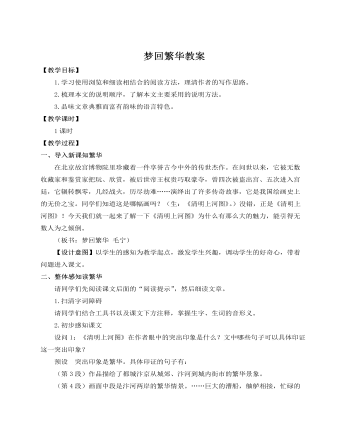
人教部编版语文八年级上册梦回繁华教案
设问2:第3段和第4段都写繁华,两段的区别是什么?预设 第3段是概括总写繁华景象,第4段则是具体描绘繁华景象。两段之间是从概括到具体的逻辑关系。【设计意图】通过细读课文,让学生在把握生字词的基础上对课文有初步的感知,可以用简单的词语概括作者所感知画面的整体特点,而且能够用文中具体的语句加以印证。以此训练学生自主把握文章重要信息的能力。三、自主探究寻繁华1.浏览课文,理清全文的说明顺序设问1:作者介绍了这幅画哪些方面的信息?在文中进行勾画批注,并说说文章可分为哪几个部分,概括主要意思。(生浏览勾画,批注交流)预设 文章分为三个部分:第1段:介绍这幅画作的创作背景,引出本文的说明对象——《清明上河图》。第2段:介绍了这幅画作的作者张择端及其创作动机。
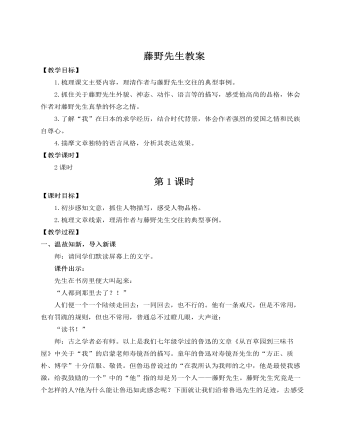
人教部编版语文八年级上册藤野先生教案
预设 清政府派遣这些留学生去国外留学,目的是学习国外先进的科学技术,回来报效国家,然而实际上他们在国外不学无术,忘记了自身使命和肩上的责任。作者在描写完留学生的这些丑态之后,采用了反语的手法,用一句话进行了总结——“实在标致极了”,仿佛是压抑不住的火山爆发,极尽讽刺之能事,酣发鄙夷、憎恶之胸臆。师:作者在这里采用了反语的手法,暗讽“清国留学生”们的丑态,除此之外,文中还有哪些地方运用了这种手法?预设 作者称日俄战争时的日本学生为“爱国青年”,说自己国内的论敌为“正人君子”,都是运用反语进行嘲讽。又如说日本对医学的翻译“并不比中国早”,说日本青年虽抗议托尔斯泰引用《新约》中的话,但他们“暗地里却早受了他的影响了”,都是话里有话,含义无穷的。【设计意图】此环节通过“咬文嚼字”,让学生学会从字里行间来品析文章深意,同时使学生进一步揣摩鲁迅先生“幽默讽刺、含蓄深蕴”的语言风格。
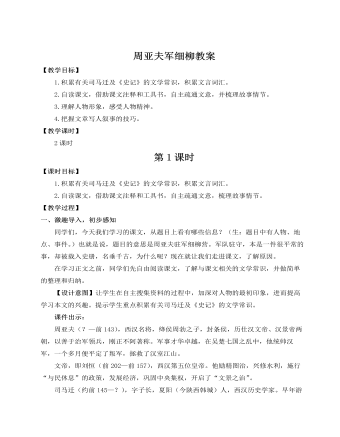
人教部编版语文八年级上册周亚夫军细柳教案
文帝之后六年,匈奴大入边。乃以宗正刘礼为将军,军霸上;祝兹侯徐厉为将军,军棘门;以河内守亚夫为将军,军细柳:以备胡。这一段主要围绕“大入边”之“大”来构建段落。整段文字看似与“大”无关,实则处处围绕“大”字做文章。写汉文帝三封将军“以备胡”,这是从内容上写胡人“入边”之“大”:边关吃紧,战势严峻。为了达到内容与形式的珠联璧合,司马迁在言语上连用三个“以……为……”的排比句式,以排山倒海的“声”势从言语上体现了“大”,以此增强文章的气势,形成一种“山雨欲来风满楼”的危急感。不仅如此,司马迁甚是在意言语细节。在连用三个“以……为……”时,打破言语的惯性,突然在第二个“以……为……”中省略了“以”字,这看似唐突,实则其心可鉴,省略第二个“以”字后,“以宗正刘礼为将军,军霸上;祝兹侯徐厉为将军,军棘门”不仅在视觉上间隔缩短,而且在朗读时彼此节奏加紧,联系更加紧密,军情更显危急,胡人“入边”之形势就显得更“大”了。而且,三个“以……为……”;“……为……”;“以……为……”之间张弛有度,一紧一松,营造了语势上的跌宕起伏,极具音韵之美。
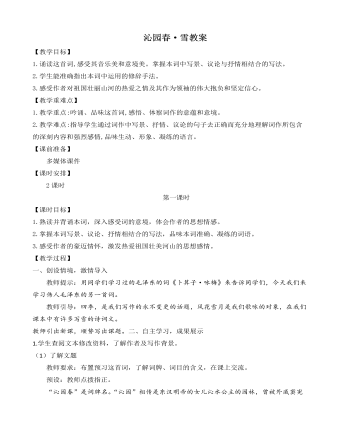
人教部编版语文九年级上册沁园春·雪教案
3. 同学们,我们再从表达方式方面去考虑一下。教师指正:写景、抒情、议论相结合。这是一首雄壮的抒情词作。上阕写景,气势磅礴、气象雄浑,而又寓情于景,句句洋溢着热爱祖国河山的豪情。下阕议论,由评论历史人物转到歌颂当代无产阶级英雄,抒发作者的豪情壮志。全词熔写景、议论和抒情于一炉,使主题鲜明突出,表现出强烈的艺术效果。五、 课堂检测,当堂反馈要求学生当堂做完下列题目,师生再共同订正,看看还有哪些知识没有掌握,教师及时要求学生巩固。六、知识迁移,拓展延伸1. 请同学们下面读一下柳宗元的《江雪》,回答后面的问题。教师:唐代著名文学家柳宗元写过的这首《江雪》,言简意深。请同学们思考分析,这首诗与《沁园春·雪》在感情基调上有什么不同?是什么原因造成的? 教师指正:柳宗元因参加革新运动失败而遭贬,他的政治思想和远大抱负不能实现,内心的苦恼与愤懑反映在诗中,就是那个卓尔不群、孤芳自赏、“独钓寒江雪”的“蓑笠翁”。而毛泽东的词作大气磅礴,格调高亢,充满了热爱祖国河山、以天下为己任的豪情壮志。这种差别,主要是由于作者所处的时代、境遇,特别是胸怀的阔狭造成的。
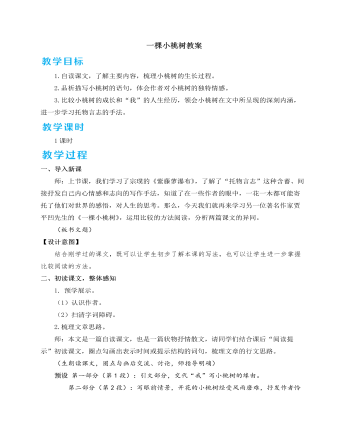
人教部编版七年级下册一棵小桃树教案
第三部分(第3—8段):写小桃树艰难曲折的生长过程。第四部分(第9—14段):回到眼前情景,生动地描写小桃树在风雨中的挣扎。3.理清小桃树的生长过程。师:作者写小桃树时,将眼前之景与回忆交叉叙写。请同学们按照时间顺序,理清小桃树的生长过程。预设 小桃树的生长过程:桃核被埋在院子角落里(“我”将它忘却)—萌芽(嫩绿)—长到二尺来高(样子极猥琐)—有院墙高了(被猪拱,讨人嫌,被遗忘,奶奶照顾)—开花(弱小,遭大雨,没有蜂蝶恋过,花零落,在雨中挣扎)—高高的一枝儿上保留着一个欲绽的花苞(在风雨中摇着愣是没掉下去,像风浪里航道上的指示灯)。师小结:小桃树的经历充满磨难:在几乎被“我”忘却的时候却破土而出;出生后瘦弱可怜,遭到大家的嘲笑,连奶奶也说它没出息;它被猪拱过,又险些被砍掉;它第一次开花就遭到风雨的摧残。但是,它一直顽强地生长,勇敢地与风雨搏斗,努力地绽放。本环节旨在运用圈点批注法理解作者对小桃树的情感。既能培养学生品析语言的能力,又能在把握小桃树意象的基础上准确体会作者的情感。
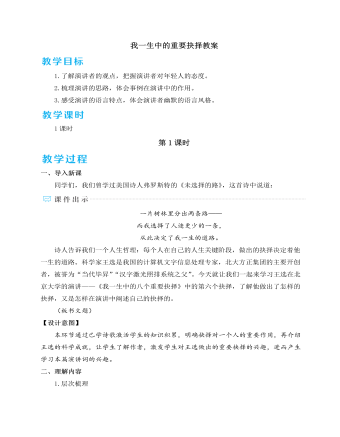
人教部编版语文八年级下册小石潭记教案
结束语:怀才不遇的柳宗元,他像陶渊明一样“采菊东篱下,悠然见南山”,也像吴均一样“从流飘荡,任意东西”,面对“凄神寒骨,悄怆幽邃”的小石潭,他选择“记之而去”,这其实体现的是柳宗元的人生态度。他有着高贵的灵魂,选择了自己想要的人生。在柳宗元身上,我们看到了古代圣贤在人生困顿之时坚守的济世情怀,那么我们又该如何实现人生的价值呢?这是我们要认真思考的一个人生命题。【设计意图】本环节通过抓住景物特点,帮助学生揣摩分析作者情感,体会寓情于景的特点。并通过插入作者的相关背景,引导学生准确把握作者心情由乐而悲的缘由,依据文本,具体深入而非概念化地理解作者“悲”的由来。三、存储总结1.师小结山水游记的写法(1)合理安排写景方法。如移步换景、定点观察等。(2)细致生动地描绘游览过程中所看到的主要景物,突出其特点。(3)巧妙地运用多种修辞手法、描写手法,使语言生动优美,富于变化。(4)融情于景,情景交融。2.推荐阅读课后阅读“永州八记”中的其他篇目。
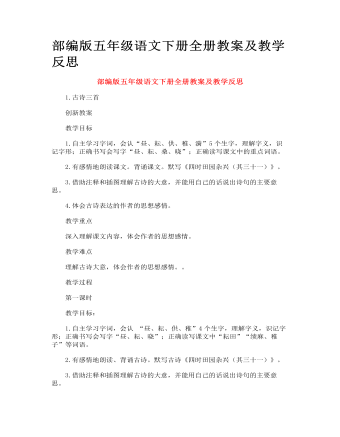
部编版五年级语文下册全册教案及教学反思
初读古诗,整体感知。 1.请同学们用自己喜欢的方式读古诗《四时田园杂兴》(其三十一)。要求借助拼音学会生字,把古诗读正确,读通顺。 2.指名多个学生朗读古诗,师生评议,纠正读得不准确的字音。尤其注意读准“昼、耘”的读音。指导读准多音字“供”([ gōng ]作动词时,准备着东西给需要的人应用:供应、供给(jǐ)、供求、供需、供销、提供、供不应求。[ góng ]奉献:供养、供献、供奉、供佛、供职;祭祀用的东西:供桌、供品、供果、上供;被审问时在法庭上述说事实:招供、口供、供状、供认、供词。)在诗中读四声。 3.把古诗反复多读几遍,通过查字典、问同学、问老师等方式,结合课文注释,理解诗句中词语的意思,用自己的话说说这首诗大体写了什么。记下不理解的地方和不明白的问题。 4.学生自愿举手发言,其他同学进行评议,也可以做补充发言。全班交流,教师相机引导并小结。
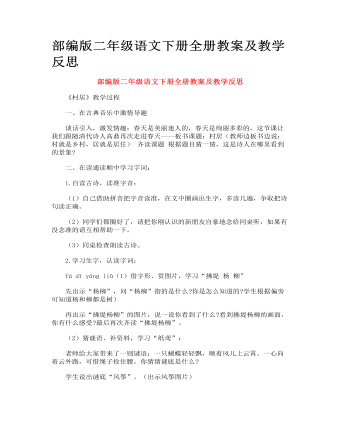
部编版二年级语文下册全册教案及教学反思
在入情入境中诵读成韵 1.配乐范读,想象画面: (1)学生边看插图边听老师配乐朗读,想象诗中所描绘的画面。 (2)学生自由交流想象中的画面,老师激励小结。 预设:山坡上的小草发芽了,嫩绿嫩绿的。黄莺在空中飞来飞去。河堤旁的柳条发芽了,几个下朋友放学回来,趁着东风,赶忙放起了风筝…… 2.借助插图,启发想象:黄莺一边飞一边干什么?(叽叽喳喳地叫)它好像在说什么? 再次启发想象:春风轻轻地吹来,柳条会怎样呢?(轻轻摆动,好像在跳舞陶醉在了美丽的春色里……) 诗人高鼎看到这样的景致写下了这样的诗句:出示“草长莺飞二月天,拂堤杨柳醉春烟”。(学生齐读) 让我们想象着春天的美丽景色,有滋有味地诵读。学生练读、指名读、引读。 3.联系生活,换位体验,:在这样美妙的春光里,沐浴着和煦的春风,(出示儿童放纸鸢图片)孩子们放起风筝,你们放过风筝吗?你放风筝时是怎样的心情?(学生自由发言)
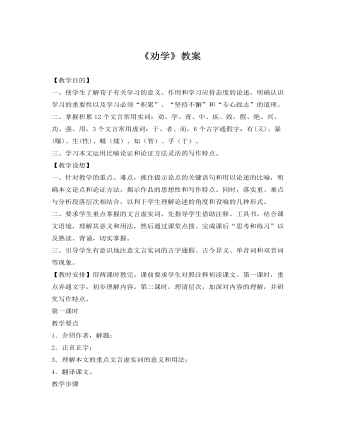
人教版高中语文《劝学》教案
(1)吾尝(曾经)终日而思矣,不如须臾(片刻)之所学也;吾尝肢(踮起脚跟)而望矣,不如登高之博见(看得广)也。(学、思对比,强调了学习的作用;跛望与登高对比,登高的收获大。两例证明利用学习、利用外物的作用。)(2)登高而招(招手),臂非加长也,而见者(看的人)远(远也看得见);顺风而呼(呼喊),声非加疾(快)也,而闻者(听的人)彰(听得更清楚)。(两例证明利用自然条件的作用。)(3)假(借助)舆马者(的人),非利足(快脚)也,而致(达到)千里;假舟楫者,非能水(善游)也,而绝(横渡)江河。(两例证明利用工具的作用。)(4)君子生(性)非异也,善假(利用)于(对)物(外物)也。连用比喻,得出结论:那些有才德的君子,生来本性与普通人没有什么两样(生非异也),只是由于他善于利用学得的知识和本领,善于利用处界条件弥补自身的不足,不断提高自己,所以才成为君子的。
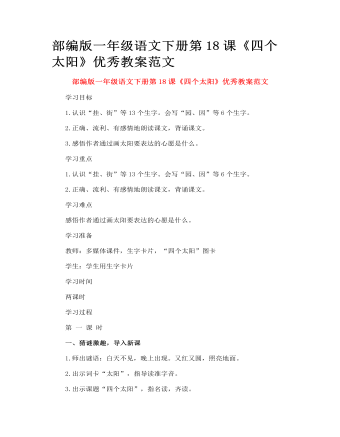
部编版一年级语文下册第18课《四个太阳》优秀教案范文
猜谜激趣,导入新课 1.师出谜语:白天不见,晚上出现。又红又圆,照亮地面。 2.出示词卡“太阳”,指导读准字音。 3.出示课题“四个太阳”,指名读,齐读。 4.引导质疑:读了课题,你的小脑瓜里是不是蹦出了小问号? 二、初读课文,认记生字 1.出示课件:带拼音生字,指名带读。 2.出示课件:去拼音生字并打乱顺序,摆字卡,自由练习朗读。 3.游戏:我说你找喊名字。 4.指导识记生字方法。 5.巩固游戏:我把生字送回家。动画演示,指导写字 1.猜谜引入:大口框里有个“大” 2.出示课件:“因”书写笔顺规则 看了动画,你知道了什么? 3.出示课件:“园” “园”与“因”哪里长得很像?书写的时候要注意些什么?(同样先里面后封口) 4.师范写“园”“因”,讲解书写要领。 5.生自由练写,师巡回指导。 6.集体评价。

新人教版高中英语必修3Unit 1 Festivals and celebrations-Discovering Useful Structure教学设计
4.That was an experience that frightened everyone. →That was _____________________. 答案:1. taking 2. being discussed 3. in the reading room 4. a frightening experienceStep 6 The meaning and function of V-ing as the predicative动词-ing形式作表语,它通常位于系动词后面,用以说明主语“是什么”或“怎么样”一种表示主语的特质、特征和状态, 其作用相当于形容词; 另一种具体说明主语的内容, 即主语等同于表语, 两者可互换。The music they are playing sounds so exciting. 他们演奏的音乐听起来令人激动。The result is disappointing. 结果令人失望。Our job is playing all kinds of music. 我们的工作就是演奏各种音乐。Seeing is believing. 眼见为实。Step 7 Practice1. It is ________(amaze) that the boy is able to solve the problem so quickly.2. Buying a car is simply _______(waste) money. 3. Please stop making the noise—it’s getting ________(annoy). 4. complete the passage with the appropriate -ing form.La Tomatina is a festival that takes place in the Spanish town Bunol every August. I think many food festivals are __________ because people are just eating. however, this festival is _________ because people don't actually eat the tomatoes. Instead, they throw them at each other! the number of people ________ part in this tomato fight, can reach up to 20,000, and it is a very __________ fight that lasts for a whole hour. The _______ thing is how clean Bunol is after the tomatoes are washed away after the fight. this is because the juice form tomatoes is really good for making surfaces clean!答案:1. amazing 2. wasting 3. annoying4. boring interesting taking exciting amazing

新人教版高中英语必修3Unit 1 Festivals and Celebrations-Reading and Thinking教学设计
The topic of this part is “Discover the reasons for festivals and celebrations.The Listening & Speaking & Talking part aims at talking about the experiences and feelings or emotions about the festivals and celebrations. This section aims at detecting the reason why the people celebrate the festivals, the time, the places, the types and the way of celebrations. It also explains why some traditions in the old celebrations are disappearing, like the firecrackers in the big cities and some new things are appearing like the prosperity of business or commerce. 1. Students can talk about what festivals they know and the reasons and the way of celebrating them.2. Students should learn the reading skills such as the headline and get the topic sentences, the structures of articles.3. Students can understand the past, the present situation of some festival around the world and why there are some changes about them. 4. Students can have the international awareness about the festivals.1. Students should learn the reading skills such as the headline and get the topic sentences, the structures of articles.2. Students can understand the past, the present situation of some festival around the world and why there are some changes about them.Step 1 Lead in---Small talkWhat festival do you like best ? Why ?I like the Spring Festivals because I can set off the fireworks, receive the lucky money and enjoy the Gala with my families.Step 2 Before reading---Pair workWhy do people celebrate different festivals ?The Spring Festivals is to celebrate the end of winter and the coming of spring and new life.The Mid-autumn Day is to celebrate the harvest and admire the moon.

新人教版高中英语必修3Unit 1 Festivals and Celebrations-Listening &Speaking&Talking教学设计
The theme of this section is “Talk about festival activities and festival experiences”.Festival and holiday is a relaxing and interesting topic for students. This part talks about the topic from the daily life of students’. In the part A ---Listening and Speaking, there are three conversations among different speakers from three countries(Japan, Rio and China), where the speakers are participating in or going to participate in the festivals and celebrations. So listening for the relationship among them is a fundamental task. Actually, with the globalization and more international communication, it is normal for Chinese or foreigners to witness different festivals and celebrations in or out of China. In the Conversation 1, a foreign reporter is interviewing a Japanese young girl who just had participated in the ceremony of the Coming-of-Age Day on the street and asking her feeling about the ceremony and the afterwards activities. Conversation 2, Chinese girl Li Mei is witnessing the Rio Carnival for the first time, and her friend Carla gives her some advice on the costumes which enables her to match with the carnival to have a good time. Conversation 3, a Chinese guide is showing a group of foreign visitors around the Lantern Festival and introducing the customs of the festival to them. The three conversations have a strong vitality and insert the festival and cultural elements from different countries. So perceiving the festivals and cultures from different countries is the second task. At the same time, the scripts also insert the targeted grammar --- v-ing as attributive and predicative, which students can perceive and experience in a real context and make a road for the further study. That is the third task. In the Part B--- Listening and Talking, the theme is “Talk about festival experience”, which is the common topic in our daily conversations. During the conversation, Song Lin, a Chinese student, asked Canadian friend Max about how to spend Christmas. In the conversation, Song Lin talked about experience and the feelings during the Chinese Spring Festival, during which there are not only some enjoyable things but some unpleasant things. After the listening, perhaps students find there are some similarities between Christmas and the Chinese Spring Festival as there are some differences in the origins and celebrations. For example, people always visit friends and relatives, decorate their houses, have a big dinner together, chat and give presents to each other.

新人教版高中英语必修3Unit 1 Festivals and Celebrations-Reading for writing教学设计二
Step 3 Analyzing article structureActivity 31. Teachers raise questions to guide students to analyze the chapter structure of this diary and think about how to describe the festival experience. (1)What should be included in the opening/body/closing paragraph(s)?(2)How did the writer arrange his/her ideas?(3)What kind of interesting details did the writer describe?(4)How did the writer describe his/her feelings/emotions during the event?2. Students read and compare the three sentence patterns in activity 2. Try to rewrite the first paragraph of the diary with these three sentence patterns. After that, students exchange corrections with their partners. Such as:●This was my first time spending three days experiencing the Naadam Festival in China’s Inner Mongolia Autonomous Region and it was an enjoyable and exciting experience. ●I'll never forget my experience at the Naadam Festival because it was my first time to watch the exciting Mongolian games of horse racing, wrestling, and archery so closely. ●I'll always remember my first experience at the Naadam Festival in China’s Inner Mongolia Autonomous Region because it was so amazing to spend three days witnessing a grand Mongolian ceremony. Step 4 Accumulation of statementsActivity 41. Ask the students to read the diary again. Look for sentences that express feelings and emotions, especially those with the -ing form and the past participle. Such as:● …horse racing, wrestling, and archery, which are all so exciting to watch. ● some amazing performances● I was surprised to see…● I was a little worried about. . . ● feeling really tiredOther emotional statements:●I absolutely enjoyed the archery, too, but the horse races were my favourite part. ●I'm finally back home now, feeling really tired, but celebrating Naadam with my friend was totally worth it. ●He invited me back for the winter to stay in a traditional Mongolian tent and cat hot pot. I can’t wait!2. In addition to the use of the -ing form and the past participle, the teacher should guide the students in the appreciation of these statements, ask them to memorize them, and encourage them to use them reasonably in writing practice.

新人教版高中英语必修3Unit 2 Morals and Virtues-Discovering Useful Structure教学设计
1. 表示时间。Hearing these stories, I’m skeptical about the place. = When I heard these stories. . . 2. 表示原因。Not knowing his address, I can’t send this book to him. = Because/Since/As I don’t know his address. . . 3. 表示结果。His father died, leaving him a lot of money. =. . . and left him a lot of money4. 表示条件。Going straight down the road, you will find the department store. = If you go straight down the road. . . 5. 表示让步。Being tired, they went on working. =Although they were tired. . . 6. 表示行为方式、伴随情况或补充说明。He lay on the grass, staring at the sky for a long time. =. . . and stared at the sky for a long time注意:非谓语动词作状语时, 如所提供的动词不能和句子中的主语保持一致, 动词-ing形式必须有自己的逻辑主语, 通常由名词或代词来担任, 这就是独立主格结构。The last bus having gone, we had to walk home. (having gone的逻辑主语是the last bus, 而不是we)Weather permitting, the football match will be played on Friday. (permitting的逻辑主语是time, 而不是the football match)Step 7 Practice1. ________(study) hard, you are sure to get first prize. 2. People use plastic in their daily life, _______(leave) large amounts of waste. 3. ________(work) hard at your lessons, you are to succeed. 4. The old man, ____________(work) abroad for twenty years, is on the way back to his motherland. 5. ______________(finish) his homework, he was playing on the playground. Answers: 1. Studying 2. leaving 3. Working 4.having worked 5. Having finishedStep 8 HomeworkFinish the homework on Page 22.
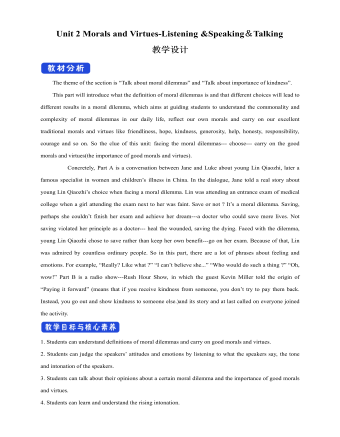
新人教版高中英语必修3Unit 2 Morals and Virtues-Listening &Speaking&Talking教学设计
Example:One day, a poor boy who was trying to pay his way through school by sending newspapers door to door found that he only had one dime(一角)left. He was so hungry that he decided to beg for a meal at the next house.However, he lost his nerve when a lovely young woman opened the door. Instead of a meal he asked for a drink of water. She thought he looked hungry so she brought him a large glass of milk. He drank it slowly, and then asked, “How much do I owe you?” “You don’t owe me anything,” she replied, “Mother has taught me never to accept pay for a kindness.” “Then I thank you from the bottom of my heart.” With these words, Howard Kelly left that house.Years later the woman became badly ill and was finally sent to the hospital in a big city. Dr. Howard Kelly, now famous, was called in. When he heard the name of the town she came from, a strange light filled his eyes. Dressed in his doctor’s clothes, Dr. Kelly went into her room and recognized her at once. From that day on, he gave special attention to her, and decided to do his best to save her life.At last the woman was saved. Dr. Kelly asked the business office to pass the final bill to him. He looked at it and then wrote something on the side. The bill was sent to the woman’s room. She was afraid to open it because she was sure that it would take the rest of her life to pay for it off. Finally she looked, and the note on the side of the bill caught her attention. She read these words: “Paid in full with a glass of milk, Dr. Howard Kelly.” Tear of joy flooded her eyes.

新人教版高中英语必修3Unit 2 Morals and Virtues-Reading and Thinking教学设计
The topic of this part is “Learn to make choices in life”.The Listening & Speaking & Talking part aims at the moral dilemmas, and this part is about making choices in life. The heroin is Lin Qiaozhi, a famous medical scientist, made a great contribution to our country’s medical care. Most importantly, her life experience can inspire our students whether in studying or the development of career. she had moral dilemmas and life choices, which are similar to the students who will step into society. Besides, Lin has quite good virtues like kindness, self-improvement, insistence, job-loving , generosity and responsibility, which is worth being learned.Concretely, this article is a biography about Lin Qiaozhi. The article tells her whole life according the timeline, among which the life choices is emphasized. For example, whether married or chased her dream, returned home or stayed abroad, family or public, her choices all reflected her faith, spirit, responsibility and devotion.1. Fast reading to get the detailed information about Lin Qiaozhi; careful reading to do the deductive information.2. Learn the reading skills--deductive judgement according the context.3. Study the structure features and language features. 4. Communicate about Lin’s life choices and reflect their own life choices.1. Learn the reading skills--deductive judgement according the context.2. Study the structure features and language features.3. Communicate about Lin’s life choices and reflect their own life choices.Step 1 Lead in---Small talkWhat are some important life choices?Importance choices: university study, jobs and marriage partners. Because they can determine our future.







